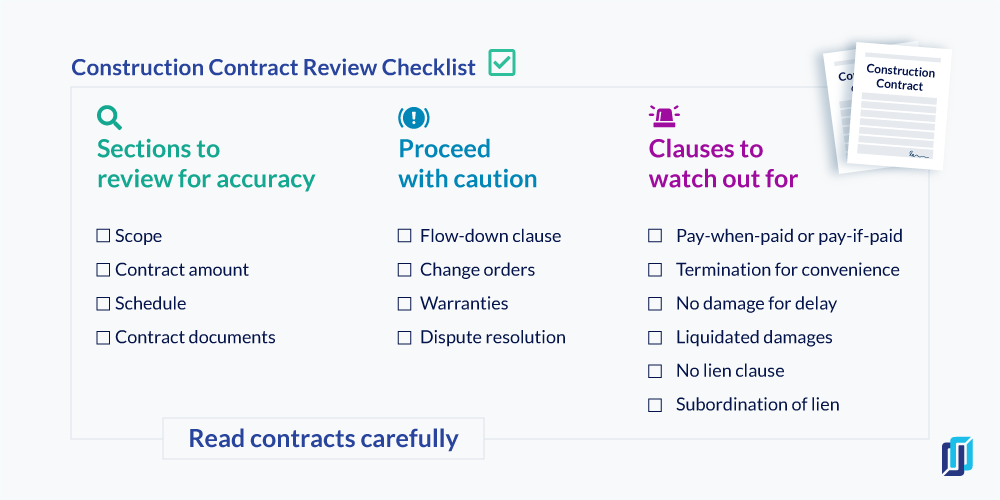
When you receive a construction contract for a new project, do you read it? The truth is most companies probably don’t. The language can be intimidating and there’s so much to read, who has time? In most cases, there’s probably no harm in signing a contract you haven’t read. However, to protect yourself and your company from potential problems, it’s best that you review each contract before signing. If you feel like you don’t know what to look for when reviewing a contract, we’ve put together a construction contract review checklist — so you know exactly which clauses to look out for, plus ideas for changes that will benefit your company.
Plus, keep reading to view a checklist you can download and print to help you keep track of all the important things to look out for every time you review a contract.
Download the contract review checklist

Construction contract sections to review for accuracy
Scope of work
The first section that you should review is the scope of work described in the contract. Make sure that it matches the work that you have offered to perform. Some contracts will provide a detailed description of the work needed, while others may be quite broad. A well-defined scope description helps all parties to the contract know exactly what work is included — as well as excluded.
Contract amount
Make sure that the contract amount matches the amount of your proposal and any agreed-upon alternates or change orders. If changes have been made to the scope of work, make sure that the changes are reflected in the scope description, as well as the contract amount.
Project schedule
Contracts may include a construction schedule or dates for the project as part of the contract language. If a schedule is included, review the dates for your work carefully. Make sure you have been given enough time to get submittal approval, order materials or equipment, and have them delivered before you start work.
Since project completion depends on everyone completing their work on time, it’s especially important to review and discover any schedule changes as early as possible.
Contract documents
The contract documents, like drawings and specifications, are often referenced in construction contracts as the basis for the scope of work.
Usually, they are considered part of the contract by being listed or incorporated into the document. Review the list of drawings and specifications and other contract documents to make sure that you have the correct versions of the documents.
Pay special attention to the dates of drawings, as they usually go through several revisions on a project. Having the wrong documents listed on the contract can create conflict when it comes time to determine the scope of work.
Dispute resolution method
Take note of the method of dispute resolution that is required by the contract. Many contracts stipulate that the parties will go to arbitration if there is a dispute. Other options include mediation or a lawsuit. You’ll also want to note who is responsible for attorney’s fees if a claim is settled or decided by a judge or arbitrator.
Clauses in your contract to watch out for
‘Pay-when-paid’ or ‘pay-if-paid’
You’ll want to be sure to check the payment clauses in the contract to determine if they include a pay-when-paid or pay-if-paid clause. These clauses attempt to delay payment to lower-tier contractors.
Pay-when-paid states that payments will be made to a subcontractor after the owner has paid the general. There’s usually a deadline for when payment will be made, such as seven days after payment from the owner. These deadlines are subject to federal and state prompt payment laws, so make sure you know which laws apply for your project.
Pay-if-paid clauses, however, create a dependency between the owner paying the general contractor and the subcontractor being paid. They shift the responsibility for non-payment from the GC to the subcontractor. You should ask for a pay-if-paid clause to be removed from the contract if possible. If the GC won’t remove it, proceed with caution.
Termination for convenience
These clauses stipulate what happens if the owner terminates the project for their own purposes. Often the clause states that contractors will only be paid for work that has been performed or installed after the date of termination. This means that materials or equipment that have been purchased and haven’t been installed yet aren’t paid for, and the contractor incurs the cost without reimbursement. This clause should be changed to include reimbursement for materials and equipment that have been purchased and haven’t been installed yet.
No damage for delay
A no damage for delay clause states that a contractor cannot be reimbursed for costs incurred by a delay caused by an upper-tier party.
For example, a subcontractor cannot claim costs for a delay caused by the owner or the GC. This means that lower-tier contractors can lose significant amounts of money waiting for upper-tier contractors to move the work along, whether they caused the delay or not. This clause should be changed to include reimbursement for damages if a delay is caused by an upstream party and is not the fault of the contractor.
Liquidated damages
Liquidated damages are penalties for completing a project after its scheduled completion time. They are assessed to help compensate the project owner for lost revenues due to a delay in the project. Liquidated damages are usually assessed by the owner to the general contractor and are often passed down to subcontractors. If there are liquidated damages on a project, make sure that the damages will be passed down only to the contractors responsible for the delay.
No-lien clause
Some contracts include clauses that require a contractor to waive their lien or bond claim rights before work starts. The waiving party ends up agreeing (whether they know it or not) to perform the work without the protection of a potential mechanics lien or bond claim against the property if they end up not getting paid.
These clauses are generally not enforceable, because you can’t build a contract on an act that goes against the law. However, you should be aware of whether or not they can be enforced in the state the work is in. Either way, you should ask to strike the clause, as it takes away a legal right you are entitled to.
Subordination of lien
Another clause you may find related to lien rights is a subordination of mechanics lien clause. Subordination of a mechanics lien relates to the mechanics lien’s priority, which is what may ultimately determine who gets paid first (or at all) in the event the lien is foreclosed on.
These clauses often state that the mechanics lien will be placed behind other liens in priority. Being at the end of the priority line can mean that you won’t get paid — even if you have a valid lien.

Protect & speed up every payment
Learn how Levelset can help you easily manage your lien rights on every project to ensure your payments are always protected.
Construction contract review: Where to proceed with caution
Flow-down clauses
Many subcontractor contracts have a clause that states that the terms of the prime contract apply to the contract with the subcontractor. These are called flow-down clauses. If you find such a clause in your contract, make sure you request a copy of the prime contract so you can review it.
Since you are agreeing to the terms of the prime contract, you have a right to review those terms. If you have a question about something in the prime contract, ask the general contractor before proceeding.
Change orders
Be sure to review the section that deals with change orders. You’ll want to know what the process for submitting changes is, what the notice deadlines are, and the process for filing a claim if a change is not accepted. If the notice deadlines are too short, negotiate to extend them so you have time to put together the required backup information.
Warranties
Most construction contracts require contractors to warranty their material and labor for at least one year. Review the warranty clauses to make sure there aren’t hidden warranty requirements that the owner or general contractor is requesting.
Sometimes they may request warranties of five or 10 years, depending on the work being provided. Make sure you know how long you have to warranty your work before you start the project.
Always read contracts carefully
The bottom line is you need to read each contract you receive carefully. If you can, have an attorney review each contract before signing it. They will suggest changes and let you know of any red flags that you need to be aware of. Always use your best judgment, and don’t be afraid to suggest changes that better protect your company.
